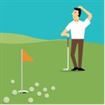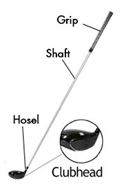A Brief Introduction to Golf Clubs for Beginners
Guest Author: Denny K. is a golf enthusiast writing buying guides and golf tips for beginners at his blog: Hitting The Golf Ball.
Golf—we get it; it isn’t an everyday thing. You might wrap your thoughts around the lifestyles of the rich and famous, of Tiger Woods and Prince William, yet you might still remain absolutely clueless about it. Golf can indeed seem terribly convoluted to the inexperienced.
With the many rules and different clubs, it’s hard to tell which from which. “What exactly do I do; did I just put my legs the right way?” “How do I practice, am I even doing things correctly?” “What kind of clubs do I need?” You might be asking the same things but worry no more as help has certainly arrived.
 As a beginner, you might still be at the stage of the game where everything may seem like some frustratingly unsolvable math problem in a textbook without a solution’s manual, and you’re the clueless student desperately trying to Google out answers. Let’s face it: it’s a sport you can practice several times a week and still be bad at. You lose more than you win and it’s seemingly impossible to even be an average player.
As a beginner, you might still be at the stage of the game where everything may seem like some frustratingly unsolvable math problem in a textbook without a solution’s manual, and you’re the clueless student desperately trying to Google out answers. Let’s face it: it’s a sport you can practice several times a week and still be bad at. You lose more than you win and it’s seemingly impossible to even be an average player.
Chances are you’ll be pretty discouraged at this point but when you finally have a hole or a shot that is absolutely perfect, you’re in love all over again. True, golf isn’t a sport designed for most people but the exhilaration and satisfaction you get from it takes all the pain away.
Since you’re just a novice, one of the most basic things you can associate with golf would be the clubs used. Clubs—the place where you spend your Friday nights at? Nope. The things you hit the golf ball with! A typical golfer’s bag consists of several types of clubs designed to give players one for every shot they meet. These clubs all vary in composition and are designed to hit the ball at varying distances and assorted degrees of loft.
A Golfer’s Bag
The most common clubs are woods, wedges, putters, and irons, though utility clubs or hybrids are sometimes used. A lot of golf club sets are specifically designed for certain skill levels, which of course include clubs especially made for beginners. The great thing about golf is that it allows players from different skill sets to gather around, play together, and get great enjoyment from it.
As a beginner, you’re probably struggling with hitting the ball consistently—a problem which could be caused by the usage of a wrong club. A novice golfer doesn’t really need a full set of 14 clubs; cutting the number down to either 9 or ten may indeed help in making club choice easier and may also boost your abilities performance-wise. For beginners, it is advisable to carry iron clubs the most because they have shorter shafts and smaller club heads than woods.
 The Parts of a Golf Club A golf club consists of several parts, all of which have its own unique qualities. To suit each player’s preferences, a grip consisting of synthetic rubber does the job. The shaft, which acts an as extension of your arms, consists of steel or graphite. Steel shafts are preferable over graphite since they have a stiffer flex and less torque, which make them more accurate. The hosel, which appears like the neck of the club head, connects to the shaft. Though greatly underrated, they are important to the overall balance, feel and power of a club.
The Parts of a Golf Club A golf club consists of several parts, all of which have its own unique qualities. To suit each player’s preferences, a grip consisting of synthetic rubber does the job. The shaft, which acts an as extension of your arms, consists of steel or graphite. Steel shafts are preferable over graphite since they have a stiffer flex and less torque, which make them more accurate. The hosel, which appears like the neck of the club head, connects to the shaft. Though greatly underrated, they are important to the overall balance, feel and power of a club.
Lastly, the club head; it is the heaviest of all components and consists of steel, titanium, tungsten, or a combination of all three. Its main feature is a large, flat, angled face that is usually scored with grooves. These grooves impart the spin on the golf ball and wisp away moisture between the ball and the club face. The head’s weight aids in producing club head speed and keeping the swing on-plane.
Factors to Consider for a Beginner Besides the more common buying factors like type of shaft, playing goals and budget, the two main factors that that make up the best beginner golf clubs are forgiveness and consistency. Forgiveness lessens the effect of bad swings and poor contact with the ball; while consistency lowers the chance of mis-hits. To achieve this, go for clubs with large head size and additional loft. And soon enough, you’ll start seeing improvements in your game!
Editor’s Note: If you are serious about the game of golf and want to really improve at the game, the best next step you can make is to get fitted for golf clubs. Every player is different. Don’t throw your money away without first finding out the specifications you need in a golf club. Call your local golf professional. Your local PGA / LPGA professional or a reputable golf retailer will have the answer.




